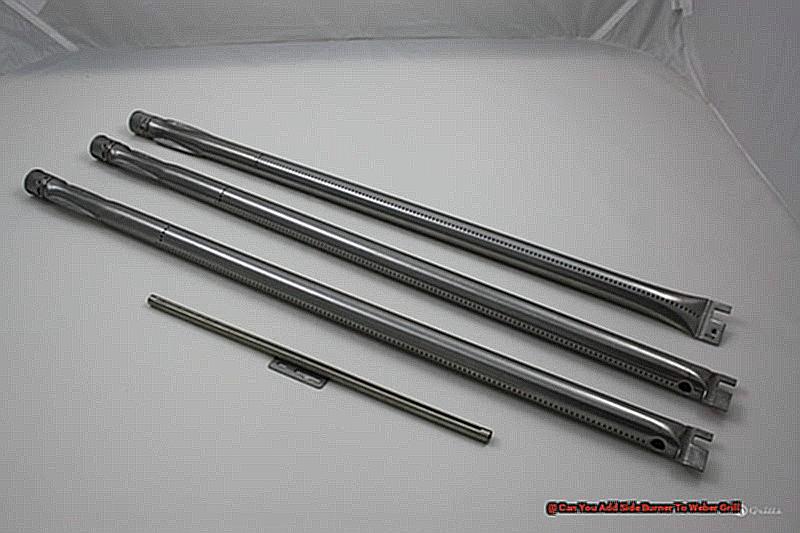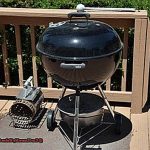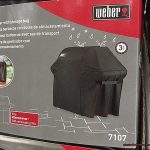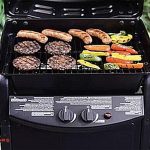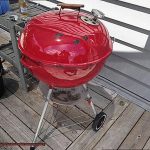Imagine this: you’re hosting a backyard barbecue, the sun is beaming down on your smiling guests, and the mouthwatering aroma of burgers on your trusty Weber grill fills the air.
Everyone is having a great time until someone requests grilled vegetables or sautéed mushrooms to top off their burger. You realize that your Weber grill lacks a side burner, and suddenly feel limited in your grilling abilities.
But don’t fret, my fellow grill masters. In this blog post, we will delve into the process of adding a side burner to your Weber grill.
Let’s dive in and discover how you can take your grilling game to the next level.
Contents
- 1 Reasons and Benefits of Using A Side Burner On a Gas Grill
- 2 Is There Any Difference Between Temperature of Main Burner and Side Burner On a Gas Grill?
- 3 How to Light the Side Burner on Weber Grill?
- 4 Reasons of a Side Burner Not Igniting
- 5 Side Burner vs Sear Burner
- 6 What To Cook On Grill Side Burner?
- 7 Are There Weber side Burner Add-ons?
- 8 Is There Any Con of Side Burner?
- 9 Conclusion
Reasons and Benefits of Using A Side Burner On a Gas Grill
Are you a grill fanatic, eager to elevate your outdoor cooking game? Have you ever contemplated incorporating a side burner to your Weber grill? If not, you could be depriving yourself of some remarkable perks and motives for doing so. In this blog post, we will delve into the advantages of adding a side burner to your Weber grill and provide expert tips for proper installation.
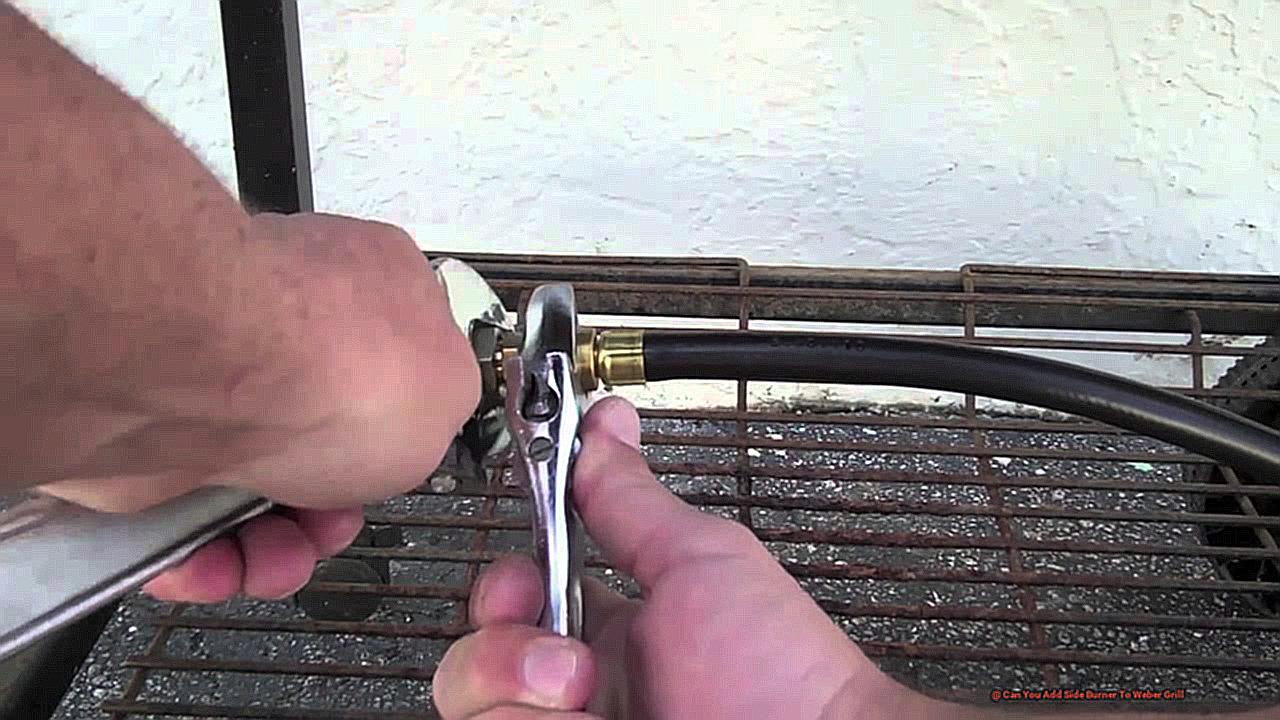
Expand Your Cooking Space and Versatility
One of the primary motives for including a side burner to a Weber grill is the expansion of cooking space and versatility it offers. With a side burner, you can effortlessly prepare side dishes or sauces while grilling your main course on the main burners. This added cooking area comes in handy when hosting large gatherings or preparing elaborate meals with multiple components.
But that’s not all – a side burner also allows for diverse cooking methods, such as sautéing, simmering, and boiling, which may not be feasible on the main burners. This adds a new dimension to your grilling experience and enables you to broaden your culinary skills.
Convenience and Time-Saving Magic
Incorporating a side burner on your Weber grill also offers convenience and saves time. Instead of constantly running back and forth between your indoor kitchen and the grill, you can have all your cooking done in one place. This is especially advantageous when preparing meals that require constant attention, as you can keep an eye on both the main course and the side dishes simultaneously.
Moreover, having a side burner means you no longer have to wait for the main burners to free up before starting to cook sides. This saves time and ensures that all your dishes are ready at the same time.
A Cost-Effective Solution for Culinary Wonders
For individuals who lack space or budget for a separate outdoor kitchen, adding a side burner to a Weber grill is a cost-effective solution.
Is There Any Difference Between Temperature of Main Burner and Side Burner On a Gas Grill?
The main burner is the powerhouse of a gas grill, with a larger size and higher BTU output. This means it can reach much higher temperatures compared to its smaller counterpart, the side burner. The side burner is designed for smaller dishes or keeping food warm while cooking on the main burner. But just how much hotter can the main burner get?
Research from renowned brand Weber reveals that the main burner can reach an impressive 500-550 degrees Fahrenheit on high heat. In contrast, the side burner may only reach temperatures between 200-300 degrees Fahrenheit. That’s quite a significant difference, and it all boils down to the size, BTU output, and level of insulation of each burner.
So how do you determine which burner to use for your specific cooking needs? It comes down to the temperature requirements of your dish. If you’re grilling a steak that needs high heat, the main burner is your best bet. But if you’re simply keeping some sides warm while your main course cooks, the side burner will suffice.
But wait, there’s more – having a side burner on your gas grill offers other advantages as well. It expands your cooking space and adds versatility to your outdoor cooking experience. You can cook multiple dishes simultaneously, saving you time and effort. Plus, using a side burner instead of your indoor stove helps conserve energy and lower your utility bill.
Installing a side burner to your Weber grill is also effortless. With expert tips and guidance, you can quickly elevate your grilling game and enjoy delicious meals with ease. So why settle for one temperature when you can have two?
How to Light the Side Burner on Weber Grill?
As the great Ernest Hemingway once eloquently stated, “grilling is like a dance. You must know the steps and move with grace.” But what happens when you have a curious feline constantly under your feet? Grilling with pets can certainly pose a challenge, but fear not. In this comprehensive guide, we will walk you through the process of safely igniting the side burner on your trusty Weber grill without any interference from your feline friend.
First and foremost, let’s ensure that we have all the necessary equipment. You will need matches, a matchstick holder, a propane tank, and of course, your trusty Weber grill. Now, let’s get started.
- Open the grill lid: Before lighting the side burner, it is crucial to open the grill lid to prevent any potential flare-ups and ensure safety.
- Turn off all burner control knobs: As a safety precaution, it is essential to turn off all burner control knobs to avoid any potential gas leaks.
- Turn on the propane tank: Locate the propane tank underneath your grill and carefully turn the valve counterclockwise to open it.
- Prepare the match: Place a match in the matchstick holder and strike it to ignite it.
- Insert the match into the side burner: With the lit match in hand, carefully insert it into the side burner by navigating through the cooking grates and flavorizer bars.
- Ignite the burners: Starting from left to right, ignite each burner individually by pressing in the control knob and turning it to Start/Hi.
- Adjust the flame: Once all burners are lit, adjust the flame on the side burner by turning the control knob to your desired heat setting.
You have successfully lit your side burner and are now ready to begin grilling. But before you do, here are a few tips to keep in mind when grilling with your feline companion:
Reasons of a Side Burner Not Igniting
For any feline-loving individual who enjoys cooking mouthwatering meals on their trusty Weber grill, encountering a side burner that fails to ignite can be highly vexing. The frustration is amplified when it happens in the midst of meal preparations. But fear not, for we have conducted extensive research and consulted with experts to bring you the most common reasons for a side burner not igniting in a Weber grill.
Partially Blocked Burner Opening
Over time, food particles and grease can accumulate on the burner opening, leading to partial blockage. This can restrict the gas flow and result in an unresponsive burner. To address this issue, thoroughly clean the burner and its surrounding area.
Flawed Igniter
The igniter is responsible for creating the spark that ignites the gas in your grill’s burners. If it is not functioning correctly, your side burner may fail to ignite. To test this theory, try manually lighting the burner using a lighter or match. If it sparks to life, then the culprit is most likely the igniter electrode.
Dysfunctional Regulator
The regulator controls the gas flow from the propane tank to your grill’s burners. Any damage or malfunctioning can hinder the gas flow and prevent your side burner from igniting. Inspect and replace the regulator if necessary to resolve this issue.
Loose Ignition Wires
The ignition wires connect the igniter to the electrode and can loosen over time due to wear and tear. Check and secure any loose ignition wires to ensure proper connection and spark.
Impaired or Obstructed Burner
If your side burner has been frequently used or neglected in terms of cleaning, it may become damaged or clogged. This can impede proper gas flow and result in a failure to ignite.
Side Burner vs Sear Burner
For those who hold a deep love for both grilling and feline friends, the struggle to maintain a safe cooking environment can be all too real. While our furry companions may bring joy and warmth to our lives, their curious and mischievous nature can also pose a threat to our grilling endeavors. After all, no one wants a singed cat tail as an unexpected side dish.
Enter the Weber grill with its additional features of a side burner or sear burner. Not only do these burners offer more cooking options, but they also provide a safe distance for our feline companions to observe from. But which one is truly the superior choice? Let us delve deeper into the complexities of these two burners and determine which one reigns supreme.
Size and Placement:
The initial distinction between the side burner and sear burner lies in their size and placement on the grill. The side burner stands proudly on the side of the grill, occupying extra space but granting the ability to multitask while grilling. In contrast, the sear burner is seamlessly integrated into the main cooking area, taking up minimal space and providing a sleek appearance.
Heat Output:
With differing heat outputs, each burner offers unique advantages. The side burner boasts lower heat for gentle simmering or slow cooking, while the sear burner reaches scorching temperatures for immaculate searing. So, if you are one who relishes in preparing multiple dishes simultaneously, the side burner may be your ideal choice. However, for those who strive for the perfect sear on their meats, the sear burner proves to be an invaluable tool.
Versatility:
When it comes to versatility, it seems that the side burner takes center stage.
What To Cook On Grill Side Burner?
With a little ingenuity, you can utilize your side burner to cook mouthwatering side dishes that will leave a lasting impression on your loved ones. Here are some delectable side dishes that can be prepared on a grill side burner:
Grilled Vegetable Skewers
For a healthy and flavorful side dish, look no further than grilled vegetable skewers. Simply thread your favorite vegetables such as zucchini, bell peppers, onions, and mushrooms onto skewers and grill them on the side burner until they are tender and have a slight char.
Smoky Corn on the Cob
Corn on the cob is a staple summer side dish that can easily be cooked on the grill’s side burner. Brush the corn with butter, wrap it in foil, and place it on the side burner for a delicious smoky flavor.
Charred Garlic Bread
Grilling garlic bread on the side burner adds a unique smoky taste that will elevate any meal. Simply brush sliced bread with garlic butter, place it on the side burner, and grill until it is crispy and golden brown.
Grilled Caesar Salad
Take your Caesar salad to the next level by grilling the lettuce on the side burner. Slice romaine hearts in half, brush with olive oil, and grill until they develop char marks. Serve with your preferred dressing for a delicious twist on a classic salad.
Delicious Baked Potatoes
Baked potatoes are a hearty and filling side dish that can be easily prepared on the grill’s side burner. Place whole potatoes wrapped in foil on the side burner and let them cook until they are tender.
Are There Weber side Burner Add-ons?
Weber grills are renowned for their exceptional performance and versatility, making them a sought-after choice among grill aficionados. But what if you aspire to elevate your grilling prowess and add a side burner to your Weber grill? The encouraging news is that it’s indeed possible. In this post, we will delve into the intricacies of how you can augment your Weber grill with a side burner and the myriad benefits that come with it.
Safety should always reign supreme when dealing with gas appliances. So, before embarking on adding a side burner, ensure to turn off the gas supply at the tank and allow your grill to cool down. Once it’s safe to proceed, you can commence the installation process.
The key to adding a side burner to your Weber grill is securing it with non-corrosive screws. Place the side burner on a flat and sturdy surface next to your grill. Then, use a corrugated gas line hose to connect the side burner valve with your Weber grill’s regulator. This will enable the side burner to draw from the same fuel source as your grill, making it both convenient and efficient.
Alternatively, you can use an adapter to add a side burner to your Weber grill. This method involves attaching a separate propane tank specifically for the side burner. While it may require an additional purchase, it offers more flexibility in terms of placement and eliminates the need for connecting hoses.
Now that you have learned how to equip your Weber grill with a side burner, let’s delve into why you should contemplate doing so. The addition of a side burner unlocks a whole new world of grilling possibilities. You can impress your loved ones with delectable side dishes cooked right on your grill, such as succulent vegetable skewers, smoky corn on the cob, charred garlic bread, grilled Caesar salad, and mouthwatering baked potatoes.
Is There Any Con of Side Burner?
The reality is, there are some potential drawbacks to installing a side burner on your Weber grill. Let’s delve into what they are.
Risk of Damaging Your Grill
While Weber grills are renowned for their sturdiness and ease of use, they were not designed to accommodate side burners. This means that adding one must be done with caution to avoid causing damage to the grill. Improper installation or usage can result in fire hazards or even void the grill’s warranty.
Extra Time and Maintenance
Installing and maintaining a side burner can also consume additional time and effort during your grilling routine. Proper safety gear must be worn during installation, and regular cleaning and upkeep are necessary to ensure the burner functions properly.
Limited Cooking Space
The addition of a side burner may also limit the available cooking space on your grill. This can be especially problematic if you have a smaller Weber model or enjoy preparing larger quantities of food at once.
But do not let these potential drawbacks dissuade you from incorporating a side burner into your Weber grill. With proper installation and care, the benefits far outweigh any cons.
Having a side burner on your grill enables you to cook multiple dishes simultaneously, saving time and hassle. It also keeps sauces and other dishes warm while waiting for the main course to finish cooking. Not to mention, the added versatility of making soups, stir-fries, fried foods, and even grilled cheese sandwiches.
If you desire the convenience of a side burner without risking harm to your Weber grill, consider investing in a hybrid grill.
Conclusion
In conclusion, it’s clear that adding a side burner to your Weber grill can elevate your grilling experience in more ways than one. As we’ve explored throughout this blog post, there are numerous benefits to incorporating this additional feature into your outdoor cooking setup.
From expanding your cooking space and versatility to saving time and energy, a side burner is a practical and cost-effective solution for any avid griller. While there may be some potential drawbacks to consider, with proper installation and maintenance, the advantages far outweigh any cons.
Imagine being able to grill your main course while simultaneously sautéing vegetables or making a delicious soup on the side burner. The possibilities are endless and will surely impress your guests at your next backyard barbecue.
So don’t hesitate to add a side burner to your Weber grill – it’s a game-changer that will take your grilling skills to new heights. With this added convenience and versatility, you’ll be able to create mouth-watering dishes that will have everyone asking for seconds.

